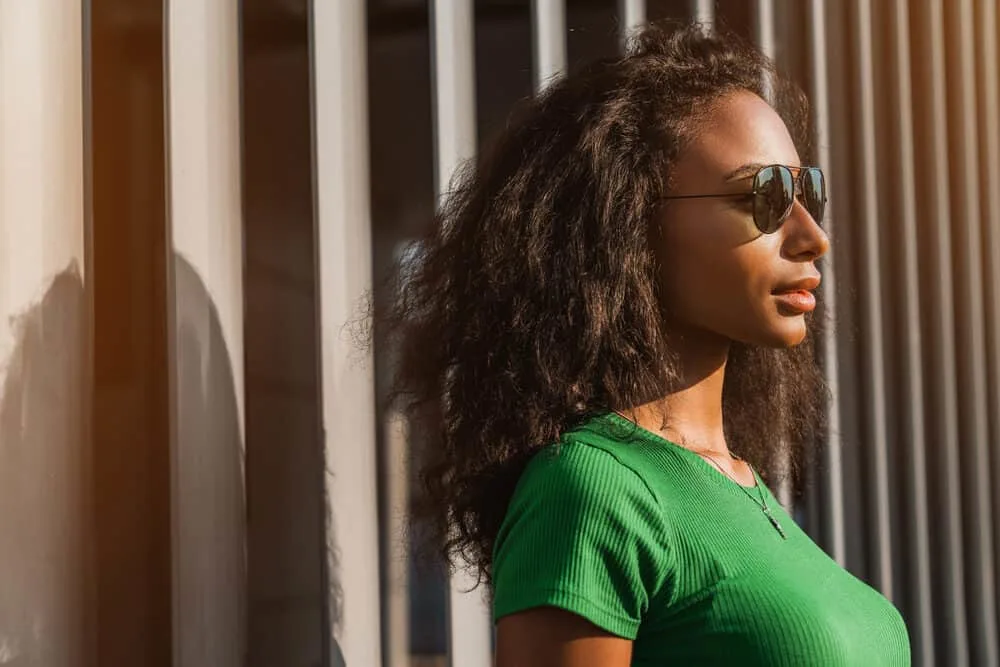
If you have natural curls, you’ve probably felt the urge to pick up a flat iron and see how it would be to go straight.
Although straightening your curls can be a welcome change, many can’t help but wonder whether it comes with a price. In this article, we will discuss whether straightening your curly hair can damage it. Let’s get right into it!
Table of Contents
Does Straightening Curly Hair Damage It?
Unfortunately, straightening your curls will surely cause some damage. Whether you use a blow dryer, curling wand, or flat iron, they all suck the life out of your delicate tresses.
While many people believe their curls can withstand occasional heat styling, some naturals experience significant damage after just one straightening session.
As harmless as straightening your hair may seem, the process causes internal and external damage to your strands that can be irreparable in some cases. In the next section, we will dive deeper into how heat styling is harmful to the health of your curls.
How Heat From a Straightener Affects Curls
The moment you expose your hair to heat styling tools, your curls begin to suffer. Read on as we explain how straightening your hair alters it.

Causes Dryness
High heat and curls is the perfect recipe for dryness. Whenever your hair comes in contact with extreme heat, its hydrogen bonds are destroyed, which results in moisture loss.
As your curls begin to dry out from repeated exposure to these high temperatures, they become dull and brittle. This is an extreme issue for curls because they tend to be dry anyway.
Causes Breakage
Frequent heat styling wears your strands down, increasing their susceptibility to breakage. This occurs because the high heat zaps your hair of moisture and protein, making it weak and brittle.
When your hair is weak, it cannot withstand much manipulation, so it breaks off easily. Moreover, some people notice significant shedding while combing and brushing after several heat styling sessions.

Causes Ends to Split
Many of us are guilty of spending way too much time touching up our ends when using flat irons. Because the ends of the hair are typically more frayed, tangled, and rough than the mid-lengths and roots, they often require more time and higher heat to achieve certain styles.
Unfortunately, overheating your ends will only damage them further and cause them to split.
Causes Thinning at the Crown of the Head
Because the crown of the head is the most visible part of your hair, it demands almost all of our attention when heat styling.
We tend to go over this area several times when flat ironing to ensure our hair is picture perfect. But when you spend excessive amounts of time heat-treating the crown of your head, the area can become badly damaged over time.

Damages Outer Layers of the Hair
Straightening your hair damages its outermost layer, called the cuticle. It serves to protect the hair’s inner structure and takes the biggest hit when you heat style your hair. Once heat begins to eat away at the cuticle layer, it is difficult (if not impossible) to repair it.
Changes Hair Porosity
Frequent heat styling damages the cuticle layer, causing it to be more raised than normal, increasing the hair’s porosity. High porosity hair cannot adequately retain moisture since its cuticles never fully shut to seal moisture in.
For this reason, those who frequently use heat styling tools often complain that their hair always feels dry no matter how much moisture they apply. This vicious cycle of dryness is caused by heat damage.

Damages Internal Structure of the Hair
Your hair is made up of a protein called keratin. It gives the hair its structure, shape, and texture. This protein has a natural twist, known as an alpha helix.
When heat styling tools reach temperatures between 419°F and 455°F, the alpha helix melts.
As a result, the internal structure of your hair strands is permanently changed, and your hair begins to take on the shape of the melted keratin. This makes your hair remain almost bone straight permanently.
Permanently Changes Curl Pattern
If you plan on heat styling your hair frequently, you should be prepared to kiss your curls goodbye. After heat damages your hair, its structure will be permanently changed.
So, it will be nearly impossible for you to achieve your original curl texture and pattern no matter how many curl creams and activators you try.
How To Minimize Damage While Straightening Hair
Straightening your hair will inevitably cause some damage to your curls, but there are ways to mitigate it. In this section, we will discuss several ways you can protect your hair when heat styling.

Deep Condition
Deep conditioning is the most important preliminary step you can take to protect your hair before applying heat. Deep conditioners help seal in moisture to shield the protective layers of hair strands from damage during heat styling.
For extra healing and nutrient absorption, let your deep conditioner sit on your hair for at least 30 minutes or even overnight before washing out.
Detangle Hair Properly
Your hair is more prone to damage when it’s tangled, so always detangle your hair the best you can before blow-drying or heat styling.
To make detangling easier, use a wide-tooth comb and a detangling cream to work through snags and knots with ease. Additionally, be sure to detangle from ends to roots to prevent breakage.
Use a Heat Protectant
Heat protectants create a barrier between the heat styling tool and your hair to minimize damage, lock in moisture, and smooth the protective layers of the hair.
After detangling, they’re designed to be sprayed on damp hair to prime it for heat styling. Most heat protectant sprays can protect your hair from temperatures as high as 450°F.

Use Low-Temperature Settings
It can be tempting to turn up the heat as high as possible when taming your curls. But if you want your hair to survive the process, keep the temperature to a minimum to avoid damage. It is best to keep temperatures no higher than 350°F.
How Often Can You Straighten Your Hair Without Damaging It?
As a general rule, you should straighten your hair no more than once per week. Still, your hair will endure some damage, but it is unlikely to be severe.
For those with colored or otherwise chemically treated hair, stick to heat styling no more than once per month. We recommend fewer heat styling sessions for processed hair because it has already been damaged by the chemicals used during the treatments.

What to Do About Heat Damaged Curls
If your curls have taken a beating from frequent heat styling, there are practical steps you can take to help your hair recover. Read on as we discuss ways you can revive your heat-damaged curls.
Trim Ends
Trimming damaged, frayed ends will help you retain healthy length as you nurse your curls back to health. If you’re nervous about cutting your own hair, consult a natural hairstylist to get the job done.
Moisturize
Your hair will need extra moisture to combat the dryness that heat damage causes. You need to moisturize at every step of your hair care routine, including washing, conditioning, detangling, and styling.
Use moisturizing shampoos and conditioners that won’t strip your hair of its natural oils. Try detangling sprays to keep hair moist while working through knots and snags. Additionally, you can set your hairstyles in place while styling using moisturizing gels.

Try Protective Styles
Protective styles allow you to rock countless gorgeous looks without damaging your hair through constant manipulation.
These styles greatly minimize the chances of breakage, tangling, and split ends. Box braids, Marley twists, Bantu knots, crochet braids, and braid updos are excellent protective styles to try while your hair heals.
- How to Keep My Natural Hair Straight in Humidity
- How to Get Rid of Burnt Hair Smell After Flat Ironing
- What Does a Dominican Blowout Consist Of?
- What to Do When Your Hair Is Curly Underneath and Straight on Top?
To sum things up, straightening your hair is risky, especially if you have natural curls. But if you plan on heat styling your hair, you can protect it by using the tips outlined in this article.
We hope this article helped educate you on the risks and best practices of straightening your curls. Good luck!
